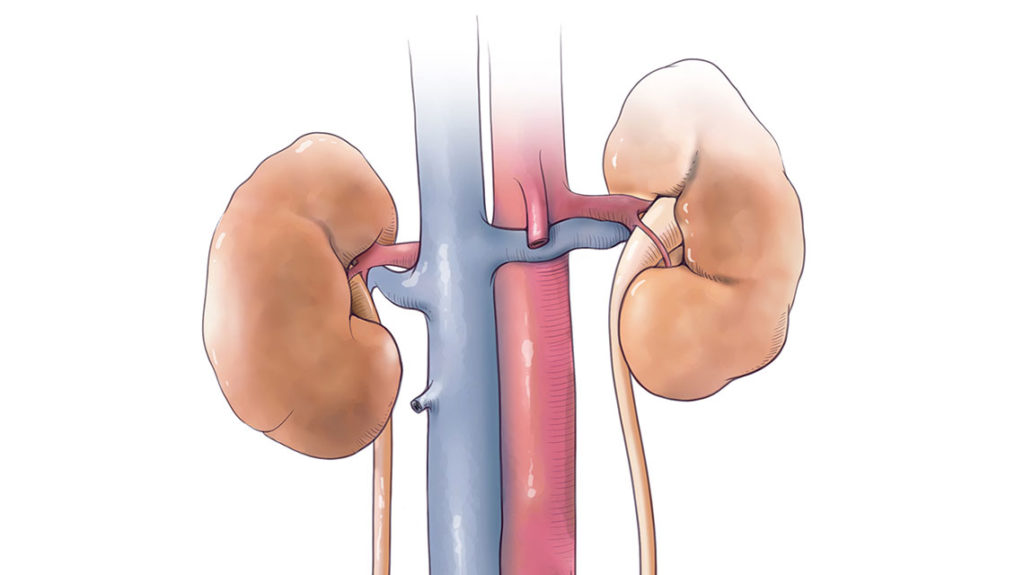Keeping in Touch: Renin-Producing Cells Require Cell Adhesion Molecule to Survive
Keeping in Touch: Renin-Producing Cells Require Cell Adhesion Molecule to Survive https://pediatricsnationwide.org/wp-content/uploads/2021/01/Urinary-system-No-Background-kidney-header-1024x575.jpg 1024 575 Lauren Dembeck Lauren Dembeck https://pediatricsnationwide.org/wp-content/uploads/2021/03/Dembeck_headshot.gif- May 24, 2021
- Lauren Dembeck

Uncovering the molecular mechanisms underlying the renin-angiotensin-aldosterone system may provide insights into the long-term effects of hypertension and antihypertensive medications.
As the main source of renin in the human body, juxtaglomerular (JG) cells are crucial for blood pressure and fluid-electrolyte homeostasis. However, these cells cannot be cultured in vitro, making it challenging to study the molecular mechanisms underlying the renin-angiotensin-aldosterone (RAAS) system.
Using an in vivo model, pediatric nephrologists Tahagod Mohamed, MD, of Nationwide Children’s Hospital and Maria Luisa D. Sequeira Lopez, MD, at the University of Virginia have discovered that cell-to-cell and cell-to-extracellular matrix interactions are essential for JG cell survival. The findings were recently published in Hypertension.
“Juxtaglomerular cells are classically known for their role in the kidney. However, their role extends beyond the kidneys to the overall regulation of fluid and electrolytes in the human body,” says Dr. Mohamed, who was the lead author of the study, which she performed as a fellow at University of Virginia. “Also, these cells are present not only in the kidney as JG cells but in other organs as well.”
Integrins are the largest family of cell adhesion molecules, which mediate cell-to-cell and cell-to-matrix interactions. Total body loss of the β1-integrin subunit, which is the integrin subunit expressed most abundantly in the kidney, is known to be incompatible with life.
To test the hypothesis that cell-matrix interactions are fundamental not only to maintain the identity and function of JG cells but also for their survival, the investigators created a unique murine model that has lost β1-integrin only in the JG cells.
“The RAAS system has been known for several decades, and it is highly conserved among different species; thus, the lessons we learn from this murine model will inform our understanding of the system in humans,” Dr. Mohamed explains.
At birth, the β1-integrin mutant mice were undistinguishable from the control mice; however, with time, the mice failed to thrive and, at 6 weeks of age, began to lose weight and became dehydrated and moribund. Periodic blood chemistry and health monitoring combined with histopathological studies showed that the JG cells died by apoptosis, resulting in decreased circulating renin, hypotension, severe renal-vascular abnormalities, and ultimately, chronic kidney disease and renal failure.
“We now understand that the communication between the JG cells among themselves, with the extracellular matrix, and other neighboring cells is extremely important for their function and survival,” says Dr. Mohamed.
The clinical significance of these findings may extend to the use of medications that block the cascade of the RAAS system, which are one of the most common medications used in adults, children and even infants with hypertension and chronic kidney disease, explains Dr. Mohamed.
“This system is not just for blood pressure regulation. It involves other parts of the body, and we don’t know what the long-term effects of using those medications in people are,” she says, “Understanding the molecular mechanisms used by JG cells will help us formulate questions and design additional studies to uncover those long-term consequences.”
How JG cells detect changes in blood pressure is not fully understood, but it likely occurs through mechano-sensation. Dr. Mohmed and colleagues now hypothesize that integrins that connect JG cells to the extracellular compartment and to neighboring cells, including those of the kidney vasculature, may transmit changes in blood pressure to the JG cells. This hypothesis will be the basis of follow up studies.
Reference:
Mohamed TH, Watanabe H, Kaur R, Belyea BC, Walker PD, Gomez RA, Sequeira-Lopez MLS. Renin-expressing cells require β1-integrin for survival and for development and maintenance of the renal vasculature. Hypertension. 2020 Aug;76(2):458-467. doi: 10.1161/HYPERTENSIONAHA.120.14959.
Image credit: Nationwide Children’s (artist, Mandy Root-Thompson)
About the author
Lauren Dembeck, PhD, is a freelance science and medical writer based in New York City. She completed her BS in biology and BA in foreign languages at West Virginia University. Dr. Dembeck studied the genetic basis of natural variation in complex traits for her doctorate in genetics at North Carolina State University. She then conducted postdoctoral research on the formation and regulation of neuronal circuits at the Okinawa Institute of Science and Technology in Japan.
-
Lauren Dembeckhttps://pediatricsnationwide.org/author/lauren-dembeck/
-
Lauren Dembeckhttps://pediatricsnationwide.org/author/lauren-dembeck/
-
Lauren Dembeckhttps://pediatricsnationwide.org/author/lauren-dembeck/
-
Lauren Dembeckhttps://pediatricsnationwide.org/author/lauren-dembeck/January 29, 2019
- Post Tags:
- Kidney
- Nephrology





